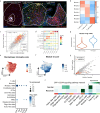Gemistocytic tumor cells programmed for glial scarring characterize T cell confinement in IDH-mutant astrocytoma
- PMID: 39880824
- PMCID: PMC11779865
- DOI: 10.1038/s41467-025-56441-5
Gemistocytic tumor cells programmed for glial scarring characterize T cell confinement in IDH-mutant astrocytoma
Abstract
Isocitrate dehydrogenase 1/2 mutant (IDHmt) astrocytoma is considered a T cell-deprived tumor, yet little is known regarding the phenotypes underlying T cell exclusion. Using bulk, single nucleus and spatial RNA and protein profiling, we demonstrate that a distinct spatial organization underlies T cell confinement to the perivascular space (T cell cuff) in IDHmt astrocytoma. T cell cuffs are uniquely characterized by a high abundance of gemistocytic tumor cells (GTC) in the surrounding stroma. Integrative analysis shows that GTC-high tumors are enriched for lymphocytes and tumor associated macrophages (TAM) and express immune cell migration and activation programs. Specifically, GTCs constitute a distinct sub-cluster of the astrocyte-like tumor cell state that co-localizes with immune reactive TAMs. Neighboring GTCs and TAMs express receptor-ligand pairs characteristic of reactive astrogliosis and glial scarring, such as SPP1/CD44 and IL-1β/IL1R1. Collectively, we reveal that T cell confinement in IDHmt astrocytomas associates with GTC-TAM networks that mimic glial scarring mechanisms.
© 2025. The Author(s).
Conflict of interest statement
Competing interests: The authors declare no competing interests.
Figures





References
-
- Wu, T. D. et al. Peripheral T cell expansion predicts tumour infiltration and clinical response. Nature579, 274–278 (2020). - PubMed
MeSH terms
Substances
LinkOut - more resources
Full Text Sources
Medical
Research Materials
Miscellaneous

